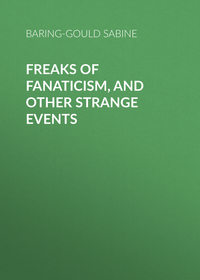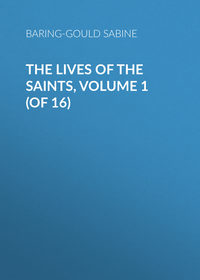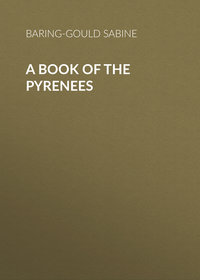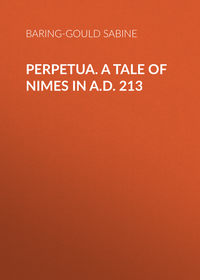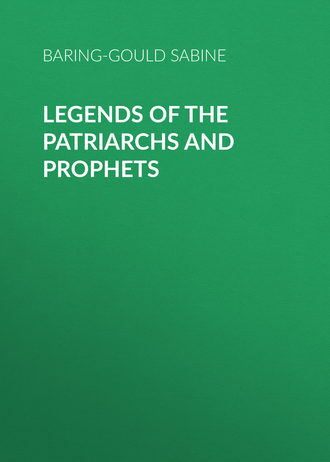 полная версия
полная версияLegends of the Patriarchs and Prophets
In the Book of Jasher the cause of quarrel is differently stated. One day the flock of Abel ran over the ground Cain had been ploughing; Cain rushed furiously upon him and bade him leave the spot. “Not,” said Abel, “till you have paid me for the skins of my sheep and wool of their fleeces used for your clothing.” Then Cain took the coulter from his plough, and with it slew his brother.108
The Targum of Jerusalem says, the subject of contention was that Cain denied a Judgment to come and Eternal Life; and Abel argued for both.109 The Rabbi Menachem, however, asserts that the point on which they strove was whether a word was written zizit or zizis in the Parascha.110
“And when they were in the field together, the brothers quarrelled, saying. ‘Let us divide the world.’ One said, ‘The earth you stand on is my soil.’ The other said, ‘You are standing on my earth.’ One said, ‘The Holy Temple shall stand on my lot;’ the other said, ‘It shall stand on my lot.’ So they quarrelled. Now there were born with Abel two daughters, his sisters. Then said Cain, ‘I will take the one I choose, I am the eldest;’ Abel said, ‘They were born with me, and I will have them both to wife.’ And when they fought, Abel flung Cain down and was above him; and he lay on Cain. Then Cain said to Abel, ‘Are we not both sons of one father; why wilt thou kill me?’ And Abel had compassion, and let Cain get up. And so Cain fell on him and killed him. From this we learn not to render good to the evil, for, because Abel showed mercy to Cain, Cain took advantage of it to slay Abel.”111
S. Methodius the Younger refers to this tradition. He says: “Be it known that Adam and Eve when they left Paradise were virgins. But the third year after the expulsion from Eden, they had Cain, their first-born, and his sister Calmana; and after this, next year, they had Abel and his sister Deborah. But in the three hundredth year of Adam’s life, Cain slew his brother, and Adam and Eve wailed over him a hundred years.”112
Eutychius, Patriarch of Alexandria, says, “When Adam and Eve rebelled against God, He expelled them from Paradise at the ninth hour on Friday to a certain mountain in India, and He bade them produce children to increase and multiply upon the earth. Adam and Eve therefore became parents, first of a boy named Cain, and of a girl named Azrun, who were twins; then of another boy named Abel, and of a twin sister named Owain, or in Greek Laphura.
“Now, when the children were grown up, Adam said to Eve, ‘Let Cain marry Owain, who was born with Abel, and let Abel have Azrun, who was born with Cain.’ But Cain said to his mother, ‘I will marry my own twin sister, and Abel shall marry his.’ For Azrun was prettier than Owain. But when Adam heard this, he said, ‘It is contrary to the precept that thou shouldst marry thy twin sister.’
“Now Cain was a tiller of the ground, but Abel was a pastor of sheep. Adam said to them, ‘Take of the fruits of the earth, and of the young of the sheep, and ascend the top of this holy mountain, and offer there the best and choicest to God.’ Abel offered of the best and fattest of the first-born of the flock. Now as they were ascending the summit of the mountain, Satan put it into the head of Cain to kill his brother, so as to get Azrun. For that reason his oblation was not accepted by God. Therefore he was the more inflamed with rage against Abel, and as they were going down the mount, he rushed upon him and beat him about the head with a stone and killed him. Adam and Eve bewailed Abel a hundred years with the greatest grief… And God cast out Cain whilst he was still unmarried into the land of Nod. But Cain carried off with him his sister Azrun.”113
The Rabbi Zadok said, “This was the reason why Cain slew Abel. His twin sister and wife was not at all good-looking. Then he said, ‘I will kill my brother Abel, and carry off his wife.’”114
Gregory Abulfaraj gives this account of the strife: “According to the opinion of Mar Theodosius, thirty years after he was expelled from Paradise, Adam knew his wife Eve, and she bore twins, Cain and his sister Climia; and after thirty more years she bore Abel and his twin sister Lebuda. Then, seventy years after when Adam wanted to marry one of the brothers with the twin sister of the other, Cain refused, asking to have his own twin sister.”115
The Pseudo-Athanasius says, “Up to this time no man had died so that Cain should know how to kill. The devil instructed him in this in a dream.”116
Leonhard Marius on Genesis iv. says, “As to what instrument Cain used, Scripture is silent. Chrysostom calls it a sword; Prudentius, a spade; Irenæus, an axe; Isidore says simply, steel; but artists generally paint a club, and Abulensis thinks he was killed with stones.” Reuchlin thinks, as iron was not discovered till the times of Tubal-cain, the weapon must have been made of wood, and he points out how much more this completes the type of Christ.117
Cain and Abel had been born and had lived with Adam in the land of Adamah; but after Cain slew his brother, he was cast out into the land Erez, and wherever he went, swords sounded and flashed as though thirsting to smite him. And he fled that land and came to Acra, where he had children, and his descendants who live there to this day have two heads.118
Before Cain slew his brother, says the Targum of Jerusalem, the earth brought forth fruits as the fruits of Eden; but from the day that blood was spilt upon it, thistles and thorns sprang up; for the face of earth grew sad, its joy was gone, the stain was on its brow.
Abel’s offering had been of the fattest of his sheep, the Targum adds, but Cain offered flax.119
Abel’s offering, say certain Rabbis, was not perfect; for he offered the chief part to God, but the remainder he dedicated to the Devil; and Cain offered the chief part to Satan, and only the remainder to God.120
The Rabbi Johanan said, Cain exclaimed when accused by God of the murder, “My iniquity is greater than I can bear,” and this is supposed to mean, “My iniquity is too great to be atoned for, except by my brother rising from the earth and slaying me.” What did the Holy One then? He took one letter of the twenty-two which are in the Law, and He wrote it on the arm of Cain, as it is written, “He put a mark upon him.”121
After Abel was slain, the dog which had kept his sheep guarded his body, says the Midrash. Adam and Eve sat beside it and wept, and knew not what to do. Then said a raven whose friend was dead, “I will teach Adam a lesson,” and he dug a hole in the soil and laid his friend there and covered him up. And when Adam saw this, he said to Eve, “We will do the same with Abel.” God rewarded the raven for this by promising that none should ever injure his young, that he should always have meat in abundance, and that his prayer for rain should be immediately answered.122
But the Rabbi Johanan taught that Cain buried his brother to hide what he had done from the eye of God, not knowing that God can see even the most secret things.123
According to some Rabbis, all good souls are derived from Abel and all bad souls from Cain. Cain’s soul was derived from Satan, his body alone was from Eve; for the Evil Spirit Sammael, according to some, Satan, according to others, deceived Eve, and thus Cain was the son of the Evil One.124 All the children of Cain also became demons of darkness and nightmares, and therefore it is, say the Cabbalists, that there is no mention in Genesis of the death of any of Cain’s offspring.125
When Cain had slain his brother, we are told in Scripture that he fled. Certain Rabbis give the reason: – He feared lest Satan should kill him: now Satan has no power over any one whose face he does not see, thus he had none over Lot’s wife till she turned her face towards Sodom, and he could see it; and Cain fled, to keep his face from being seen by the Evil One, and thus give him an opportunity of taking his life.126
With regard to the mark put upon Cain, there is great diverging of opinion. Some say that his tongue turned white; others, that he was given a peculiar dress; others, that his face became black; but the most prevalent opinion is that he became covered with hair, and a horn grew in the midst of his forehead.
The Little Genesis says, Cain was born when Adam was aged seventy, and Abel when he was seventy-seven.
The book of the penitence of Adam gives us some curious details. When Cain had killed his brother, he was filled with terror, for he saw the earth quivering. He cast the body into a hole and covered it with dust, but the earth threw the body out. Then he dug another hole and heaped earth on his brother’s corpse, but again the earth rejected it.
When God appeared before him, Cain trembled in all his limbs, and God said to him, “Thou tremblest and art in fear; this shall be thy sign.” And from that moment he quaked with a perpetual ague.
The Rabbis give another mark as having been placed on Cain. They say that a horn grew out of the midst of his forehead. He was killed by a son of Lamech, who, being shortsighted, mistook him for a wild beast; but in the Little Genesis it is said that he was killed by the fall of his house, in the year 930, the same day that Adam died. According to the same authority, Adam and Eve bewailed Abel twenty-eight years.
The Talmud relates the following beautiful incident.
God had cursed Cain, and he was doomed to a bitter punishment; but moved, at last, by Cain’s contrition, he placed on his brow the symbol of pardon.
Adam met Cain, and looked with wonder on the seal or token, and asked, —
“How hast thou turned away the wrath of the Almighty?”
“By confession of sin and repentance,” answered the fratricide.
“Woe is me!” cried Adam, smiting his brow; “is the virtue of repentance so great, and I knew it not! And by repentance I might have altered my lot!”127
Tabari says that Cain was the first worshipper of fire. Eblis (Satan) appeared to him and told him that the reason of the acceptance of Abel’s sacrifice was, that he had invoked the fire that fell on it and consumed it; Cain had not done this, and therefore fire had not come down on his oblation. Cain believed this, and adored fire, and taught his children to do the same.128
Cain, says Josephus, having wandered over the earth with his wife, settled in the land of Nod. But his punishment, so far from proving of advantage to him, proved only a stimulus to his violence and passion; and he increased his wealth by rapine, and he encouraged his children and friends to live by robbery and in luxury. He also corrupted the primitive simplicity in which men lived, by the introduction amongst them of weights and measures, by placing boundaries, and walling cities.129
John Malala says the same: “Cain was a tiller of the ground till he committed the crime of slaying his brother; after that, he lived by violence, his hand being against every man, and he invented and taught men the use of weights, measures, and boundaries.”130
The passage in Genesis “Whosoever slayeth Cain, vengeance shall be taken on him sevenfold,”131 has been variously interpreted. Cosmas Indopleustes renders it thus, “Whosoever slayeth Cain will discharge seven vengeances;” that is, he will deliver him from those calamities to which he is subject when living.132
But Malala renders it otherwise; he says it is to be thus understood: “Every murderer shall die for his sin, but thou who didst commit the first homicide, and art therefore the originator of this crime, shalt be punished sevenfold; that is, thou shalt undergo seven punishments.” For Cain had committed seven crimes. First, he was guilty of envy; then, of treachery; thirdly, of murder; fourthly, of killing his brother; fifthly, this was the first murder ever committed; sixthly, he grieved his parents; and seventhly, Cain lied to God. Thus the sin of Cain was sevenfold; therefore sevenfold was his punishment. First, the earth was accursed on his account; secondly, he was sentenced to labor; thirdly, the earth was forbidden from yielding to him her strength; fourthly, he was to become timid and conscience-stricken; fifthly, he was to be a vagabond on the earth; sixthly, he was to be cast out from God’s presence; seventhly, a mark was to be placed upon him.
The Mussulmans say that the penitence of Cain, whom they call Kabil, was not sincere. He was filled with remorse, but it was mingled with envy and hatred, because he was regarded with disfavor by the rest of the sons of Adam.
Near Damascus is shown a place at the foot of a mountain where Cain slew Abel.133
The legends of the death of Cain will be found under the title of Lamech.
“Half a mile from the gates of Hebron,” says the Capuchin Friar, Ignatius von Rheinfelden, in his Pilgrimage to Jerusalem, “begins the valley of Mamre, in which Abraham saw the three angels; the Campus Damascenus lies toward the west; there, Adam was created; and the spot is pointed out where Cain killed his brother Abel. The earth there is red, and may be moulded like wax.”134 Salmeron says the same, “Adam was made of the earth or dust of the Campus Damascenus.” And St. Jerome on Ezekiel, chap. xvii., says: “Damascus is the place where Abel was slain by his brother Cain; for which cause the spot is called Damascus, that is, Blood-drinking.” This Damascus near Hebron is not to be confused with the city Damascus.
VII
THE DEATH OF ADAM
According to a Mussulman tradition, Adam was consoled for the loss of Abel by the discovery of how to make wheat-bread. The story is as follows: —
The angel Gabriel was sent out of Paradise to give him the rest of the wheat-grains Eve had plucked from the forbidden tree, together with two oxen, and various instruments of husbandry. Hitherto he had fed on roots and berries, and had known nothing of sowing grain; acting under Gabriel’s directions, he ploughed the land, but the plough stuck, and Adam impatiently smote one of the oxen, and it spoke to him and said, “Wherefore hast thou smitten me?”
Adam replied, “Because thou dost not draw the plough.”
“Adam!” said the ox, “when thou wast rebellious, did God smite thee thus?”
“O God!” cried Adam to the Almighty, “is every beast to reproach me, and recall to me my sin?”
Then God heard his cry, and withdrew from beasts the power of speech, lest they should cast their sin in the teeth of men.
But as the blow was still arrested, Adam dug into the soil, and found that the iron had been caught by the body of his son Abel.
When the wheat was sprung up, Gabriel gave Adam fire from hell, which however he had previously washed seventy times in the sea, or it would have consumed the earth and all things thereon. In the beginning, wheat-grains were the size of ostrich eggs, but under Edris (Enoch) they were no bigger than goose eggs; under Elias they were the size of hen’s eggs; under Christ, when the Jews sought to slay him, they were no larger than grapes; it was in the time of Uzeir (Esdras) that they diminished to their present proportions.
After Adam and Eve had been instructed in all that appertained to agriculture, Gabriel brought them a lamb and showed Adam how to slay it in the name of God, how to shear off the wool, and skin the sheep. Eve was instructed in the art of spinning and weaving by the angel, and she made of the wool, first a veil for herself, and then a shirt for her husband.
The first pair brought up their grandsons and great grandsons, to the number of 40,000 according to some, and 70,000 according to others, and taught them all that they had learned of the angel.
After the death of Abel, and after Cain had been slain by the avenging angel, Eve bore a third son, named Seth, who became the father of the race of the prophets.
Finally, when Adam had reached his nine hundred and thirtieth year, the Angel of Death appeared under the form of a goat, and ran between his legs.
Adam recoiled with horror, and exclaimed, “God has given me one thousand years; wherefore comest thou now?”
“What!” exclaimed the Angel of Death, “hast thou not given seventy years of thy life to the prophet David?”
Adam stoutly denied that he had done so. Then the Angel of Death drew the document of transfer from out of his beard, and presented it to Adam, who could no longer refuse to go.
His son Seth washed and buried him, after that the angel Gabriel, or, according to some accounts, Allah himself, had blessed him: Eve died a year later.
Learned men are not agreed as to the place of their burial; some traditions name India, others the Mount Kubais, and others again, Jerusalem – God alone knows!135
Tabari says that Adam made Seth his testamentary executor.
“When Adam was dead, Gabriel instructed Seth how to bury him, and brought him the winding sheet out of heaven. And Gabriel said to Seth, ‘Thou art sole executor of thy father, therefore it is thy office to perform the religious functions.’ Then Seth recited over Adam thirty Tebírs. Four of these Tebírs were the legal prayers, the others were supererogatory, and were designed to exalt the virtues of Adam. Some say that Adam was buried near Mecca, on Mount Abui-Kubais.”136
According to the apocryphal “Life of Adam and Eve,” Adam before his death called to his bedside all his sons and daughters, and they numbered fifteen thousand males, and females unnumbered. Adam is said to have been the author of several psalms; amongst others Psalm civ., Benedic anima mea, and Psalm cxxxix., Domine probasti; as may be gathered from the 14th, 15th, and 16th verses: “My bones are not hid from thee: though I was made secretly, and fashioned beneath in the earth. Thine eyes did see my substance, yet being imperfect; and in Thy book were all my members written; which day by day were fashioned, when as yet there was none of them.”
The Arabs say that when Adam dictated his last will and testament, the angel Gabriel descended from heaven to receive it, accompanied by sixty-two millions of angels, each provided with clean white sheets of parchment and pens, and that the will was sealed by Gabriel.137
Tradition is not agreed as to the place of Adam’s burial. Khaithemah says that Adam was buried near Mecca on Mount Abu-Kubais. But the ancient Persians assert that he was buried in Ceylon, where his sepulchre was guarded by lions at the time of the war of the giants.138
But the most generally received tradition is this: —
The body of Adam was taken by Noah into the ark, and when the ark rested on Ararat, Noah and his sons removed the body from it, and they followed an angel who led them to the place where the first father was to lie. Shem or Melchizedek – for they are one, as we shall see presently – being consecrated by God to the priesthood, performed the religious rites; and buried Adam at the centre of the earth, which is Jerusalem; but, say some, he was buried by Shem along with Eve, in the cave of Machpelah, in Hebron. But others relate that Noah on leaving the ark distributed the bones of Adam among his sons, and that he gave the head to Shem, who buried it in Jerusalem. Some, taking this mystically, suppose that by this is meant the sin and punishment of Adam, which was transmitted to all the sons of Noah, but that to Shem was given the head, the Messiah who was to regenerate the world.139 S. Basil of Seleucia says: “According to Jewish traditions, the skull of Adam was found there (i. e., on Golgotha), and this, they say, Solomon knew by his great wisdom. And because it was the place of Adam’s skull, therefore the hill was called Golgotha, or Calvary.”140
With this a great concourse of Fathers agree; whose testimony has been laboriously collected by Gretser in his famous and curious book “De Cruce.” And this tradition has become a favorite subject for artists, who, in their paintings or sculptures, represent the skull of Adam at the foot of the Cross of Christ.
The apocryphal “Testament of Adam” still exists.
The tomb of Eve is shown at Jedda. “On entering the great gate of the cemetery, one observes on the left a little wall three feet high, forming a square of ten to twelve feet. There lies the head of our first mother. In the middle of the cemetery is a sort of cupola, where reposes the navel of her body; and at the other extremity, near the door of egress, is another little wall also three feet high, forming a lozenge-shaped enclosure: there are her feet. In this place is a large piece of cloth, whereon the faithful deposit their offerings, which serve for the maintenance of a constant burning of perfumes over the midst of her body. The distance between her head and feet is four hundred feet. How we have shrunk since the creation!”141
The bones of Adam and Eve, says Tabari, were taken by Noah into the ark with him, and were reburied by him.
This article may be fitly concluded with the epitaph of Adam, composed by Gabriel Alvarez, and published by him in his “Historia Ecclesiæ Antediluvianæ,” Madrid, 1713.
“Here lies, reduced to a pinch of dust, he who, from a pinch ofdust; was formed to govern the earth,Adam,The son of None, the father of All, the stepfather of Alland of himself.Having never wailed as a child, he spent his life in weepingthe result of penitence.Powerful, Wise, Immortal, Just,he sold for the price of disobedience, power, wisdom, justice,immortality.Having abused the privilege of Free-will, which weaponhe had received for the preservation of Knowledge and Grace,by one stroke he struck with death himself and all the human race.The Omnipotent Judgewho in His Justice took from him Righteousness, by His Mercyrestored it to him whole again:by whose goodness it has fallen out, that we maycall that crime happy, which obtained such and so greatA Redeemer.Thenceforth Free-will, which he in happiness used tobring forth Misery, is used in Misery to bring forthHappiness.For if we, partakers of his pernicious inheritance, partakealso of his penitential example, and lend our earsto salutary counsels,Then we (who by our Free-will could lose ourselves) can be savedby the grace of the Redeemer, and the co-operation of ourFree-will.The First Adam Lived to Die;The Second Adam Died to Live.Go, and imitate the penitence of the First Adam;Go, and celebrate the Goodness of the Second Adam.”VIII
SETH
When Seth had ascended the throne of his father, says Tabari, he was the greatest of the sons of Adam. Every year he made the pilgrimage to the Kaaba, and he ruled the world with equity, and every thing flourished during his reign. At the age of fifty he had a son; he called his name Enoch, and named him his executor. He died at the age of nine hundred.142
Seth and the other sons of Adam waged perpetual war against the Dives, or giants, the sons of Kabil, or Cain.
Rocail was another son of Adam, born next after Seth.
He possessed, says the Tahmurath Nâmeh, the most wonderful knowledge in all mysteries. He had a genius so quick and piercing, that he seemed to be rather an angel than a man.
Surkrag, a great giant, son of Cain, commanded in the mountains of Kaf, which encompass the centre of the earth. This giant asked Seth to send him Rocail, his brother, to assist him in governing his subjects. Seth consented, and Rocail became the vizier or prime minister of Surkrag, in the mountains of Kaf.
After having governed many centuries, and knowing, by divine revelation, that the time of his death drew nigh, he thus addressed Surkrag: “I am about to depart hence and enter on another existence, but before I leave, I wish to bequeath to you some famous work, which shall perpetuate my name into remote ages.”
Thereupon Rocail erected an enormous sepulchre, adorned with statues of various metals, made by talismanic art, which moved, and spake, and acted like living men.143
According to the Rabbinic traditions, Seth was one of the thirteen who came circumcised into the world. The rest were Adam, Enoch, Noah, Shem, Terah, Jacob, Joseph, Moses, Samuel, David, Isaiah, and Jeremiah.144 The book Schene Luchôth says that the soul of righteous Abel passed into the body of Seth, and afterwards this same soul passed into Moses; thus the law, which was known to Adam and in which Abel had been instructed, was not new to Moses.145
The Little Genesis says, that Seth was instructed by the angels in what was to take place in the world; how its iniquity was to grow, and a flood was to overwhelm it; and how the Messiah would come and restore all things. Seth was remarkable for the majesty and beauty of his appearance, as he had inherited much of the loveliness of unfallen man. He married his sister Azur, or, according to others, Noræa or Horæa.



